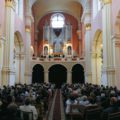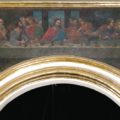Saint Sophia Cathedral in Polotsk is the oldest stone building in Belarus. Over the ten centuries of its existence, it has been destroyed and restored several times. Today, the snow-while structure in Vilnian Baroque attracts tourists who come to admire its beautiful proportions and to learn about its exciting history.
We can judge the appearance of the original cathedral constructed in the second half of the 11th century only from pictures. It was built by architects invited by the Polotsk prince Vseslav, the legendary hero and sorcerer of the ancient Russian chronicles. Historians believe that it was a cross-in-square church with three apses, topped with seven helm-shaped domes.
Some parts of the original building have been preserved up to this day, including the solid foundation of the cathedral, the altar apses, the western and eastern walls 8 and 12 meters high, the synthronon (a semicircular bench) as well as fragments of 11th-centrury frescoes. They can be seen at the Museum of the history of architecture of the Sophia Cathedral. In the early Middle Ages, the cathedral was the center of the whole Principality of Polotsk and home to the Archbishop’s chair. In case of war, the citizens could find refuge behind the thick walls of Saint Sophia Cathedral.
The period between the 16th and the 17th centuries was especially rough for the cathedral. At that time, Polotsk was the battleground between Russia and the Grand Duchy of Lithuania. The cathedral was demolished and burnt down several times during the war, and was also converted from a Russian Orthodox church into a Uniate church as a result of political turmoil.
During the Great Northern War between Russia and Sweden (1700–1721), the cathedral was turned into a gunpowder depot by the order of Peter I. Unfortunately, the depot exploded and caused a lot of damage. Only in 1738, the Uniate Archbishop Florian Hrebnicki invited the architect Jan Krzysztof Glaubitz from Vilnius to restore the church. After the reconstruction, the cathedral became a North-facing three-nave single-apse basilica. The ancient foundation and the remains of the walls and apses of the 11th century were included in the new temple. On the south side, two symmetrical towers were built, both reaching the height of 50 meters. The Vilnian Baroque-style interior of the cathedral acquired a new look with baroque columns, stucco decorations, and ornately shaped cornices. The altar part was separated from the central nave by a high three-tiered barrier, with its top part adjoining the bas-relief image of the New Testament Trinity that has survived to the present day. The first and second tiers were painted and decorated with sculptures. A copy of Leonardo da Vinci’s “Last Supper” and an image of the Holy Savior from the altar murals have survived.
In the early 20th century, during the anti-religious campaign, the temple was turned into a local history museum. During the World War II, the cathedral was reopened, but was closed again after the war and used as an archive and a warehouse.
Restoration works in Saint Sophia Cathedral began in 1969. The works were supervised by the famous Belarusian architect Valery Slyunchenko. Once the restoration was completed, the Museum of the history of architecture of the Sophia Cathedral and a Concert hall for chamber and organ music were opened in the cathedral. The first concert under the ancient arches of the church took place in 1983, when the “Cantabile” band performed works from the Polotsk Notebook created in the 16th century. In 1985, the majestic sounds of organ could be heard in the cathedral for the first time. The organ for Saint Sophia Cathedral was manufactured and installed by a Czech firm Rieger Kloss. Since then, the concert hall of Saint Sophia Cathedral has been hosting festivals of ancient and modern chamber, and every Sunday visitors can listen to organ music performed by the soloist of the concert hall. Saint Sophia Cathedral has heard voices of world-famous singers and performances of organists from the Vatican, Germany, France, Austria, Switzerland, Latvia, Ukraine, Russia and other countries.
Today Saint Sophia Cathedral is an architectural monument, a concert hall with unique acoustics, and a museum where visitors can see the ruins of the 11th temple. The new functions did not distort but rather enriched the temple’s nature, because it was built to survive through centuries and carry beauty and light from generation to generation.
Tamara Dzhumantayeva,
director of the Polotsk National Historical and Cultural Museum-Reserve





